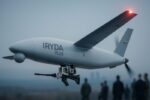Lockheed Martin has pulled back the curtain on its entry into the rapidly evolving “loyal wingman” space with a new stealthy uncrewed combat air vehicle (UCAV). The design represents a strategic pivot by the aerospace giant—best known for manned platforms like the F-22 and F-35—toward autonomous systems that will shape future air dominance. The drone is being positioned for the U.S. Air Force’s Collaborative Combat Aircraft (CCA) program under Next Generation Air Dominance (NGAD).
Lockheed’s Loyal Wingman Concept Breaks Cover
At AFA’s Air & Space Forces Association Warfare Symposium in February 2024, Lockheed Martin unveiled renderings of its loyal wingman concept—a sleek, tailless stealth drone with angular lines and low-observable shaping reminiscent of its F-22 and F-35 lineage. While no physical prototype has yet been displayed publicly, company officials confirmed that flight testing is already underway at undisclosed locations.
The aircraft is designed to operate as part of a manned-unmanned team alongside fifth- and sixth-generation fighters. It will be capable of executing high-risk missions such as suppression of enemy air defenses (SEAD), electronic warfare (EW), ISR (intelligence-surveillance-reconnaissance), and decoy operations—all while preserving human pilots for decision-making roles.
John Clark, vice president and general manager of Lockheed’s Skunk Works division, stated that their approach emphasizes modularity and mission flexibility. “We’re not building just one drone—we’re building an ecosystem,” he said during a media briefing. This aligns with USAF goals to field multiple CCA variants tailored to different mission sets.
Designed for Survivability and Autonomy
The Lockheed loyal wingman features a flying wing configuration optimized for radar evasion from multiple aspects. Its internal weapons bays suggest strike capability without compromising stealth. While exact dimensions remain classified, analysts estimate a wingspan between 9–12 meters based on renderings compared to known assets like Kratos’ XQ-58A Valkyrie or Boeing’s MQ-28 Ghost Bat.
A key differentiator will be onboard autonomy powered by artificial intelligence (AI). Lockheed has previously demonstrated AI-enabled teaming in its Have Raider II experiments and continues to invest in human-machine interface development through Project Hydra and other DARPA programs.
- Autonomy stack: Designed to allow independent navigation, threat detection/avoidance, target engagement under ROE constraints
- C2 integration: Compatible with Link-16 and future Tactical Data Links; supports distributed C2 via airborne gateways or satellites
- Modular payloads: Swappable bays for EW pods, EO/IR sensors, radar jammers or kinetic munitions
This level of autonomy allows CCA drones to operate in contested environments where GPS may be denied or comms degraded—key requirements outlined by Air Force planners.
The CCA Program Context: A High-Stakes Competition
The U.S. Air Force’s Collaborative Combat Aircraft initiative aims to field at least 1,000 uncrewed aircraft by the early 2030s to accompany NGAD fighters—and potentially legacy jets like F-35As—in contested airspace. The idea is not just force multiplication but survivability through distributed lethality.
In April 2024 testimony before Congress, Secretary of the Air Force Frank Kendall reaffirmed that two vendors would be selected in FY2025 to proceed into full-scale development under Increment 1 of CCA. Boeing (with its MQ-28-based offering), Anduril Industries (with Fury), General Atomics Aeronautical Systems Inc., Northrop Grumman, and Lockheed Martin are all competing under current Phase II contracts awarded in August 2023.
The service has emphasized affordability—targeting unit costs between $10M–$25M depending on mission role—and attritability without sacrificing capability. That balance is driving innovation across propulsion systems (including adaptive cycle engines), composite structures using additive manufacturing techniques, and secure AI integration frameworks.
A Shift in Strategy for Lockheed Martin
This marks a notable strategic shift for Lockheed Martin from traditional manned platforms toward scalable unmanned systems architecture. While Boeing was first out of the gate with operational loyal wingmen via Australia’s MQ-28 Ghost Bat program—and Kratos has been flying XQ-series drones since 2019—Lockheed brings unmatched experience integrating stealth design with advanced avionics across multi-domain battle networks.
The company also benefits from vertical integration across sensors (via L3Harris acquisition), software-defined radios like Open Mission Systems-compliant STITCHES architecture developed with AFRL/DIU support, and cyber-hardened mission computers built around open standards like FACE/MOSA.
If selected as one of two finalists next year under CCA Increment 1 contracts—which could exceed $6 billion over this decade—Lockheed would likely leverage production capacity at Palmdale Skunk Works facilities alongside its Fort Worth assembly lines already producing F-35s at scale.
Operational Implications: Redefining Aerial Warfare
Loyal wingmen are not merely expendable drones—they represent a doctrinal evolution toward distributed massed effects enabled by AI-driven teaming tactics. In simulated wargames run by RAND Corporation and MITRE over recent years involving peer adversaries like China or Russia in Indo-Pacific scenarios:
- Manned-unmanned teams increased survivability by >40% compared to manned-only formations
- Saturation attacks using coordinated UCAV swarms overwhelmed IADS more effectively than cruise missiles alone
- Cognitive offloading allowed pilots to focus on high-level decisions while drones executed tactical maneuvers autonomously
This paradigm shift also raises questions around ethical use-of-force delegation to machines—a topic currently being addressed via DoD’s Responsible AI Guidelines published in June 2023—and how command authorities will manage kill chains involving autonomous assets within OODA loops compressed below human reaction time thresholds.
What Comes Next?
The U.S. Air Force plans initial flyoffs between vendor prototypes starting late FY2024 into early FY2025 before downselecting two winners for Increment 1 low-rate production contracts by Q3 FY2025 (~July–September). IOC could occur as early as FY2028 depending on funding stability through FYDP cycles.
If successful in securing one of those slots—or even if not—Lockheed’s loyal wingman platform positions it well beyond NGAD alone; export variants could follow under Foreign Military Sales regimes tailored toward NATO allies seeking affordable fifth-gen capabilities without full fighter procurement costs.









